Five years ago, hyper-casual games were already released. Then one of the first studios in this market was St. Petersburg AYA games. In 2015, she worked with Ketchapp. Today the studio creates hits with Voodoo. Collected 30 million installations in March-May Draw Joust! — one of them. We talked with its founders about how the market and the studio itself have changed over this period. By Artem Merenfeld and Yaroslav Rudakov.

Draw Joust!
Alexander Semenov, Senior Editor App2Top.ru : You released the first hyper-casual game (GC) with Ketchapp in 2014. Do you feel like veterans of this niche?
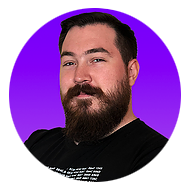
Artem Merenfeld
Artem Merenfeld, co-founder of AYA games: Definitely. Flappy Bird is considered to be the historical beginning of the hyper-casual era, and it was released in 2013, so the veteran is still rushing!

Yaroslav Rudakov
Yaroslav Rudakov, co-founder of AYA games: Moreover, I prefer to consider us the pioneers of this niche. Our The Tower is the twelfth hyper—casual game released by Ketchapp. Besides, half of these twelve came out when we were polishing our own with might and main. So, definitely, we were one of the first.
Then you worked together. Moreover, the first games were developed in their spare time. AYA games today — is it still two people or something more?
Artem: All these years outsourcers/freelancers have been helping us, but on a permanent basis AYA games is still me and Yaroslav.
But now we’ve finally decided that it’s too hard together, we still need to expand. So at the moment we are looking for developers to join the team.
Despite the fact that you have been on the market for a long time, judging by the official website of the studio, you have not had so many projects. There were big pauses between releases a couple of times. Why did this happen, because it is generally assumed that hyper-casual games are not made for several years?
Artem: The GC games themselves are made quickly, but a lot of time is spent on prototyping, selecting and screening out ideas.
For almost 6 years we have:
- released 5 hits (The Tower, Skyward, The Tower: Assassin’s Creed, Clumsy Climber and Draw Joust!), which collected 70 million installations;
- in addition to them, they were fully released (with Ketchapp) 3 more GC games that failed;
- 17 well-polished prototypes were launched into the softlonch;
- a dozen prototypes were made, but eliminated at the stage of marketing tests;
- another 50 pieces of internal prototypes were developed.
As for the ideas remaining at the level of concept art, it makes no sense to count them.
GK games are made quickly, but, objectively, it is necessary to lay down the time that will take to find working mechanics.
Yaroslav: Unfortunately, even despite our experience, we cannot come up with exceptionally brilliant ideas.
The hypercausal market depends largely on luck. There is still no recipe for creating a guaranteed hit. Any developer who has embarked on this path should be ready to try a lot and make a lot of mistakes. For large publishers, this unreliability of the market is “compensated” by the abundance of those who want to get into it: many small studios make many small games, from which someone regularly shoots. For small teams like ours, success is possible only through perseverance.
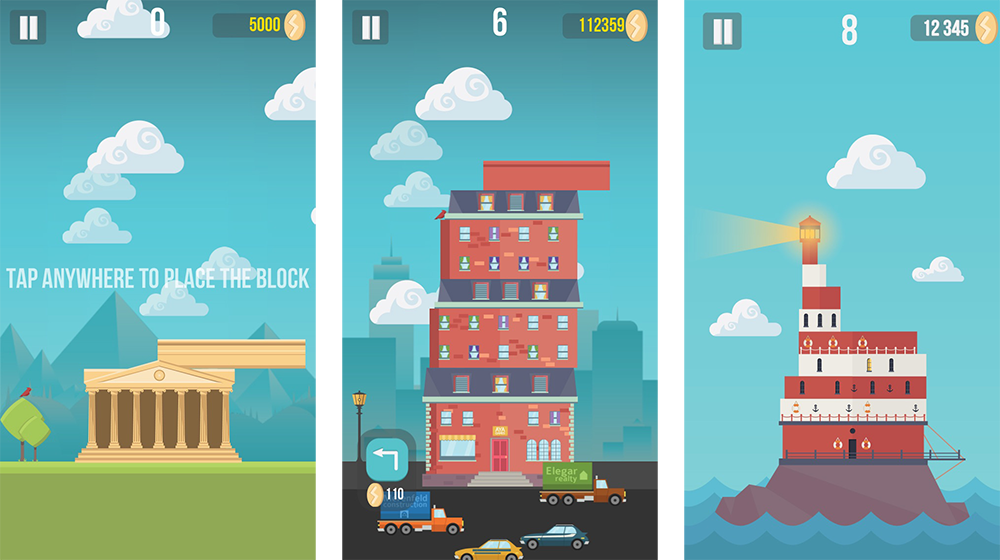
The Tower
You have been observing the hyper-casual market from the inside all the time of its development. Therefore, I can’t help but ask a banal, but at the same time difficult, complex question to answer about how exactly the niche for developers has changed during this time?
Artem: Work in the GC niche is based on the interaction of publishers and developers.
When we started, there was actually one publisher — Ketchapp. Now, of course, there is also one dominant player — Voodoo, but there are also a dozen smaller publishers that you can work with if you don’t fit the Voodoo metrics.
There are effective testing pipelines, upfront and other joys that make working with GC less like a casino and more like a business.
There were a lot of developers themselves, the competition was higher, ideas began to be exhausted, re-iterated. Today, whatever you come up with, most likely, someone has already tested it. For this reason, the quality of execution has become a priority.
Personally, I like this niche much more now. It works calmly, especially if you know that you are good at making games.
At the same time, the games have changed a lot, right? A hyper-casual game for success today must necessarily be three-dimensional, with some kind of complex meta? Or can something two-dimensional and simple still shoot?
Artem: The games themselves have gone an interesting way from minimalistic floppybird-like “impossible” games to win-win satisfying mechanics based purely on pleasant sensations. Now the market is shifting towards what will be called “hybrid-casual”, but in fact these are just games, such as we are used to seeing them: more content, more meta, fewer balls with cubes as characters.
Very simple games can still shoot perfectly, especially if you judge only by the installations for the first month. But now in GK, as in any other mobile games, player retention is put in the first place, and for it, as a rule, it is necessary to increase the game “meat”.
But — attention — it makes no sense to increase it if the basic mechanics are not interesting in themselves. Therefore, nothing prevents you from starting with a purely basic gameplay, and then adding something to it. Most often, this is exactly what is done.
Jaroslav: Yes, indeed, three-dimensional games are trending now, but this does not mean that they have become more difficult to make. It’s like comparing painting and sculpture. Which is more difficult — to paint a picture or to sculpt a statue?
It’s not about the plane or the volume, but the quality of the picture. And in this regard, the market still does not require a high bar: if you look closely at the top games, you will notice that most of them are made on the basis of free (or very cheap) graphics from the Unity Asset Store.
A complex meta is even less a must for a successful game. First you do the basic mechanics. If it works, then you make a meta on top of it. But this is not necessary, you will just earn a little less without meta. So it is absolutely possible to say that a simple one can also shoot (and shoots) still.
Due to the partial complication of production, do I understand correctly that it is already unrealistic to enter the market today without a team of only two people?
Artem: On the contrary, it is real, and small teams are still successfully entering this market.
GK games are not particularly difficult to develop, and the number of people in the team does not so much determine your ability to make a GK hit, as the ability to make X-prototypes per month to find your mechanics. There are even examples of solo developments among recent hits. For example, Woodturning 3D by Misha Vykhristenko.
In particular, Voodoo is looking for a good basic mechanics first of all, and if it satisfies all the necessary KPIs, then after the release they have a whole development team that helps to increase content.
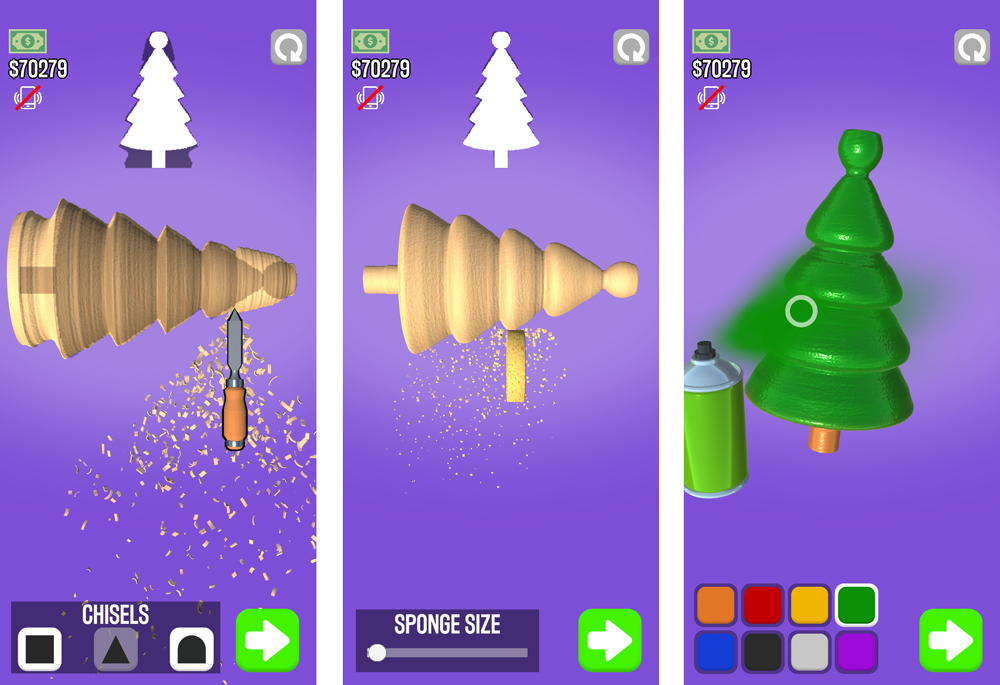
Woodturning 3D
There is another question that has been tormenting me for a long time. I hope you can answer it. You published the first games with the pioneer of the hyper—casual market – Ketchapp company. And she really was the market leader from the very beginning. What happened, why did the company go, conditionally, to the second division?
Artem: The market has matured, Ketchapp did not understand these changes. Five years ago, Ketchapp raised games to the top of the top simply due to its cross-promo in already released games. No one had such traffic, and all the developers went to them.
The procedures were not perfect. It was possible to make a game by 50%, show it to the publisher, get “OK, do it further”, finish it by 99% and then get at best the answer “we are not interested anymore”, and at worst — never get any answer at all. The whole publishing process was completely opaque and subjective.
We released most of our hits with Ketchapp, but the collaboration was quite stressful, each project was a roulette game, this was one of the main reasons why we were afraid to expand ourselves, and also why they could not compete with new publishers.
I know that today they are trying to change their approach in order to catch up with other publishers. Let’s see what happens. They have Ubisoft resources, maybe they will still be able to adapt to the current market, but it will be difficult for them to return the developers’ location.
You have chosen Voodoo as your partner for the new game. Can you tell us a little bit about how they decided to give up working with Ketchapp and how they came to Voodoo, how they managed to get her into publishers?
Artem: Important note: it wasn’t so much that we tried to get Voodoo as their publisher, as they tried to get us as their developer, knowing that we know how to make good games.
This was the first striking difference between Voodoo and Ketchapp and other publishers.
“Getting out” to them was not something difficult, we met when they had already released 3 big games, the last of which was Snake vs Block, and had not released almost any “passing” games. I was interested in such stability, so we called them, got acquainted, and their philosophy made a huge impression on me then.
You worked with a market leader five years ago and are working with a leader (but a different one) now. How fundamentally different are the approaches to work? What’s new here?
Artem: When Voodoo appeared in 2017, they became the first GC publisher practicing a coaching approach: they put the developer first, their task was to share knowledge as much as possible and teach developers to make hits faster and more efficiently.
Specific KPIs were set, necessary for the payback of the game on a certain UA. The developers clearly knew what they needed to do to get closer, everything is transparent and clear.
There were also softlonches of prototypes, regular meetings, etc. In general, the approach has become more scientific, thoughtful and effective.
Yaroslav: Now you won’t surprise anyone with this, but in 2017 it seemed amazing: we no longer had to come up with a game that Ketchapp would like, but we just had to make it meet clear certain criteria. It was akin to the appearance of chemistry instead of alchemy: instead of intuition and mysterious rituals, numbers and scientific methods have come.
Once we started talking about publishers. What conditions are accepted to offer today? What can an average studio of hyper-casual games count on when developing an average game success rate (up to 2-3 million downloads), and how much can the company earn today on a hit (from 8-10 million installations)?
Artem: GC-the market is somewhat categorical. It’s hard to make money on an average game here. It all comes down to two fairly simple figures: CPI (the cost of attracting a player) and LTV (how much this player will earn for his entire life cycle).
If CPI is lower than LTV, then traffic can be driven into the game for as long as this balance is maintained. And if your game scales well and this ratio persists for a long time, then you have a hit, and a hit is much more than 8-10 million installations. If the game scales poorly, then this will most likely manifest itself even before your game reaches 2-3 million installs.
Specifically, Voodoo’s average hit will bring the developer about $ 1 million. But this figure may be much smaller if it turns out that the game does not scale well, or, conversely, more, since Voodoo pays bonuses depending on the number of installations.
And now we are smoothly moving on to your new game — Draw Joust. The idea of your first project, The Tower, according to your own words, matured for several years until you realized it. And how did the story of Draw Joust begin?
Artem: The creation of Draw Joust was already at a very mature stage of our studio, so there was no special romance there.
As a rule, we choose a certain one mechanic and then try to look at it from every possible angle, come up with different ways to implement it. In the case of Draw Joust, which we started developing in January, we started testing everything related to drawing. After five different prototypes on this topic, we found the mechanics that showed the highest results and turned into a full-fledged game.
Yaroslav: At the end of 2019, Voodoo had the opportunity to conduct CTR tests, which significantly accelerated the testing of new ideas for viability. If before that I had to spend 2-4 weeks creating a fully working prototype, uploading it to the App Store and testing, then CTR tests require only a video that Artem can make in a few days even without my participation.
At that time, our thoughts were occupied with various ideas related to drawing. We went through a whole bunch. In mid—January, Artem had an idea about cars made of balls, as a variation on another game from Voodoo – Draw Cars. By the way, the working name of the project was “Loshariki”, in honor of the old Soviet cartoon about a horse made of balls, it was very similar to these our cars.
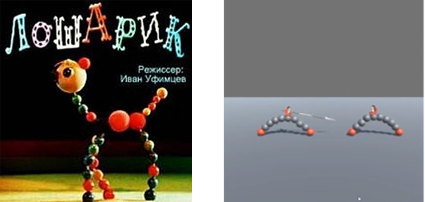
Losharik and the first prototype Draw Joust!
By the end of the month, it became clear that the idea was working. It took about another month to create a prototype and test it. The basic metrics (retention and CPI) of this game were not very high, but there was an outstanding daily playtime. Voodoo, without delay, offered us a cherished contract.
Five years ago, talking about the development of the same The Tower, you said that the price of development tended to zero. For Draw Joust! this is hardly fair, how long and by what forces was the game made?
Artem: The cost of the project should include not only the development of the game itself, but also the development of all prototypes. We made the game itself from prototype to release in two months, but add here another year of searching, prototyping and constant market research. By the way, we still regularly update and improve the project, fill it with content.
Yaroslav: No, if we talk specifically about Draw Joust, then this is just a story of rapid success. Except for a couple of years spent looking for a good idea. In any case, time is still our only investment, apart from the negligible costs of buying graphics or ready-made libraries. The main part of this project is very simple, we coped with it in just a couple of weeks.
The game uses a lot of tricks that are invisible to most players. For example, the game pretends that you are fighting with other players, but in reality, of course, this is not the case. Moreover, there is not even an artificial intelligence of the opponent: he just repeats your movements with a slight delay. The leveling system and levels create the illusion of progress, but in fact these buttons do nothing at all. Etc.
In addition, after the conclusion of the contract, the publisher allocated us a team of developers who helped and still help to add new gadgets to the game, connect advertising, statistics and other boring things. This helped us a lot and once again made it clear that it was time for us to expand the team
Were there really no difficulties at all?
Artem: Most of the problems have already arisen at the stage of updating and supporting the game. Any game has the lowest CPI on release, and then it starts to grow constantly, so in order for the game to remain profitable, we have to raise LTV all the time. To do this, various new features, balance and parameters are being tested all the time. We can confidently say that after the release of the GC hit, the amount of work only increases.
Jaroslav: The main difficulty, in my opinion, was to find a working idea. This is difficult not only in terms of labor intensity, but also in psychological terms: even if you spend only a couple of weeks on a prototype, during this time you have time to fall in love with it. And it’s good if an insufficiently successful idea immediately shows itself badly! It often happens that the idea seems to be quite good, but a little short. You start working on it, trying to improve it, and in the end you throw it away anyway. And if it goes on for a year… But I’m not complaining: it’s not easy, but it’s damn interesting!
Previously, you used Action Script (Flash) + Starling for development. As I remember, you were completely satisfied with the functionality then. What are you using now and how much more comfortable or, perhaps, on the contrary, less convenient has everything become?
Artem: Now we, like, perhaps, everyone, use Unity. Of course, everything has become more comfortable and convenient. Unity has a huge functionality, knowledge base and ready-made assets. Except that sometimes there is not enough control, which was given by such a basic engine as Air, and our builds weighed 10 times less.
Jaroslav: We had to switch to Unity because Flash support was getting weaker, but we never regretted it. Of course, Flash had its strengths. And, of course, Unity is also not without drawbacks. But, in general, it has become noticeably easier, primarily due to the huge knowledge base. You don’t have to write many routine things yourself, it’s enough to find out how others did it. This allows you to concentrate on your idea, and not waste time inventing another bike.
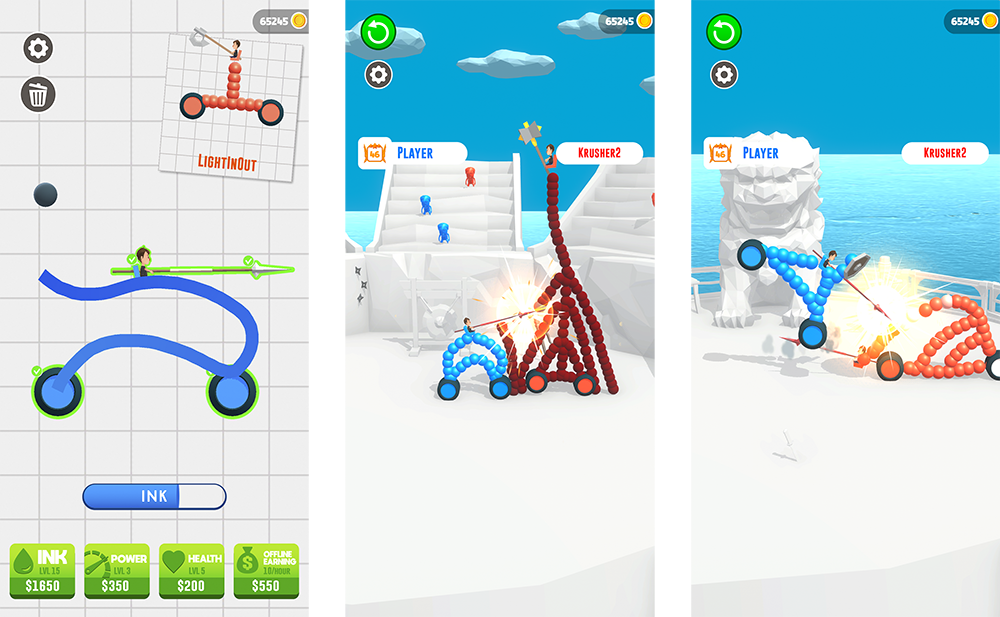
Draw Joust!
Five years ago, when developing a hyper-casual game, there was no need to think about three-dimensional graphics, physics, PvP, progression… In general, about everything that is why hyper-casual games today can’t really be called minimalistic. Were you more interested in making games then or now?
Artem: Personally, I’m definitely more interested now. I’m a pretty hardcore gamer, so the convergence of GK games with more traditional genres pleases me. Of course, because of this, development has become longer and more expensive, but it also brings more satisfaction.
Jaroslav: As I said before, 3D graphics do not complicate the work. Often — on the contrary, it makes it easier. Working with 3D, you do things closer to what you are dealing with in real life. For example, to create a depth effect, in 2D you have to resort to all sorts of tricks, like the parallax effect, and in 3D this depth is there simply because it is 3D. So it has not become more difficult in technical terms. Rather, the quality criteria have changed. If earlier completely hacky crafts were sometimes fired, today the bar has risen. But if you look at our old games, the same The Tower, for example, then note that it stands out from its peers with its quality. For example, there was such a small bird that flew from floor to floor as you build a tower. She is not needed there at all and is not involved in the game in any way, for sure, a lot of players did not notice her at all. But I spent a few days to adjust her behavior. Even then we spent a lot of effort on polishing, satisfying our perfectionism. Sometimes there was a feeling of annoyance: we spend so much effort to do something cool, and these hacks got something on their knees in a couple of weeks, and now they occupy the same first place in the top as we did two months ago. Now this happens less and less, so we are happy.
Draw Joust is by far your most successful release. The game has collected more than 30 million installations in the spring. Against the background of changed market conditions (more competition, increased marketing prices, and so on), do you now also get a lot more financially as a developer, or was success better commercialized earlier?
Artem: Without naming specific figures, I can say that now GC-hit will bring the developer several times more money than five years ago with similar positions in the top. But it has become more difficult to find such a hit, the chances of accidentally releasing something brilliant and successful have been minimized.
Many studios are now saying that they are working on a stream, that they have a new prototype coming out every two weeks. Is this story relevant to you, too, or are you going to take a big break again now?
Artem: Right now we are focused on supporting and updating Draw Joust. But we are already looking for someone to add to the team just in order to return to active prototyping and testing. No pauses, just figachit.
Jaroslav: It will definitely look like a pause from the outside, but I hope it will be short-lived. We do not plan to rest on our laurels, but we will continue to look for our next hit. There is a great aphorism: “Do what you like, and you won’t work a day in your life.” And also about a shark that drowns if it stops. Both are about us: we like what we do, and we are not going to stop.
Great! Thank you for the interview and good luck!
***
By the way, this is our second interview with AYA games. We took the first one just five years ago, when the studio released its first two hits — The Tower and Skyward. It can be read at this link.
Is there any news? Share it with us, write to press@app2top.ru
